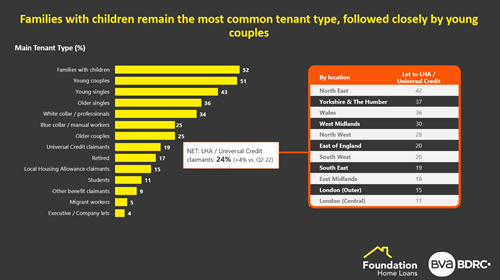Your Business and Industry
Popular BTL properties and tenant types
Landlords have always had to carefully assess any property investment and take a huge number of considerations into account to ensure it fits into their portfolio and be a profitable investment in its own right over the medium to longer term.

Over the years, many property types have been ‘in vogue’ for landlords and tenants, meaning it’s always interesting to keep track of the most commonly owned type of rental property at any given time.
As such, the latest BVA BDRC Landlord Panel research for Q3 2022 outlined that terraced houses remained the most commonly owned type of rental property, followed by individual flats and semi-detached houses.
Over 6 in 10 landlords were reported to have at least one terraced house in their portfolio, while 50% own individual flats, and 44% semi-detached houses. Landlords with the largest portfolios continue to have a more diverse portfolio and are considerably more likely to own less common property types such as HMOS, detached houses and/or whole blocks of flats.
On a regional basis, landlords letting in the North and Midlands continue to be most likely to own houses, while flat ownership in London is higher than that of the rest of the country.
When it comes to portfolio sizes, the data highlighted that the ‘typical’ landlord has 9.9 tenancies across an average of 8.0 properties. Landlords operating in the West Midlands currently have the largest portfolios with an average of 13.2 properties, whilst the typical portfolio in Yorkshire & The Humber is also in excess of 10 properties at 12.4 properties on average.
In terms of tenants, families with children remain the most common tenant type, followed closely by young couples. The typical landlord houses 3.5 different tenant segments across their 9.9 tenancies; tenant diversity appears to be greatest in Yorkshire & The Humber with an average of 4.4 different tenant types let to per landlord. Almost 1 in 4 landlords currently let to LHA or UC claimants, an increase of 4% vs the previous quarter, with this much more common for those letting in the North East (42%), Yorkshire & The Humber (37%) and Wales (36%).

This data offers a good snapshot of the property types held by landlords in different parts of the country and the tenants they are letting these properties to. With tenant demand expected to grow, it will be interesting to see if there are any variations in these trends in Q4 and into 2023 and how landlords might react to them.
FOR INTERMEDIARIES ONLY



